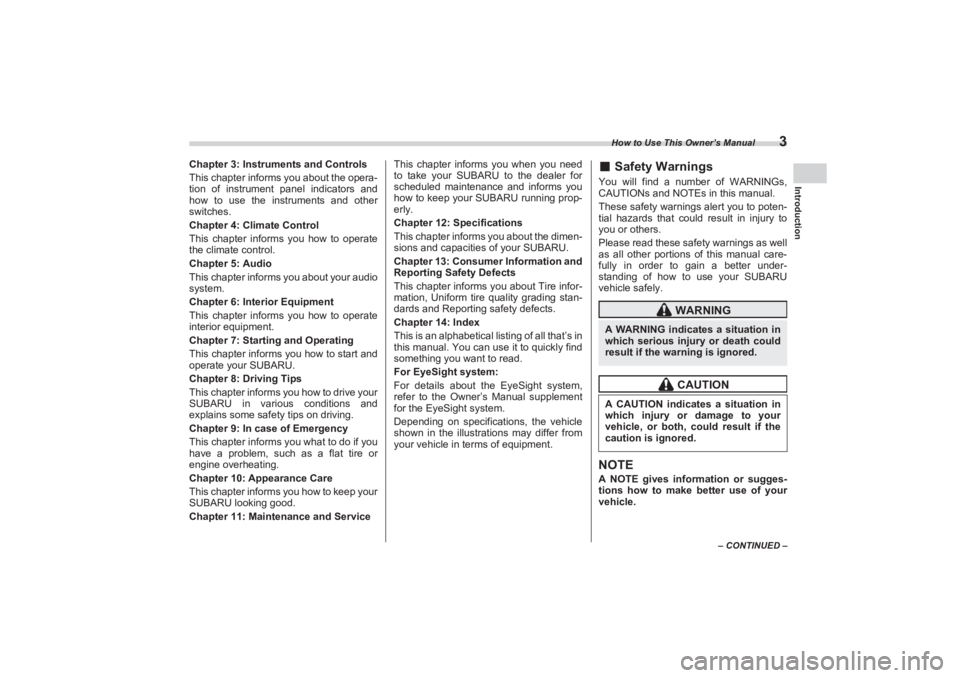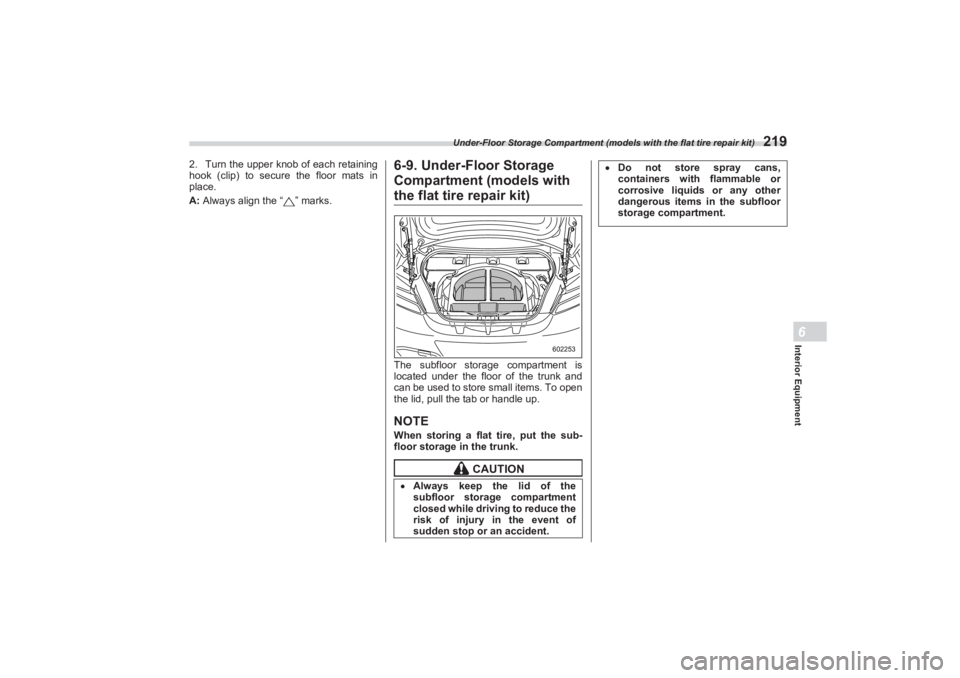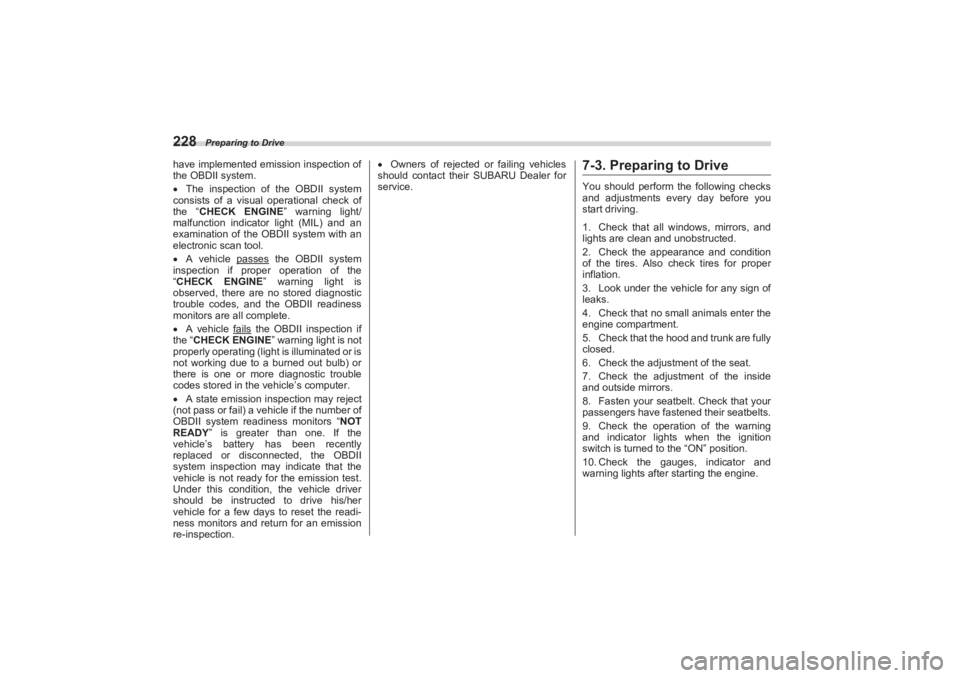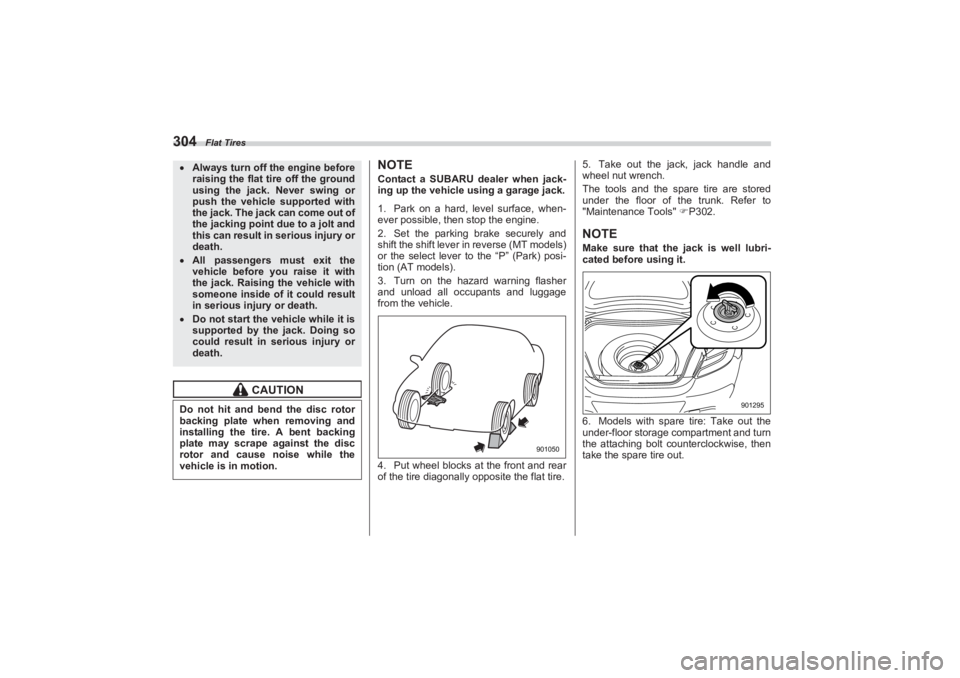2023 SUBARU BRZ run flat
[x] Cancel search: run flatPage 9 of 432

How to Use This Owner’s Manual
3
Introduction
– CONTINUED –
Chapter 3: Instruments and Controls
This chapter informs you about the opera-
tion of instrument panel indicators and
how to use the instruments and other
switches.
Chapter 4: Climate Control
This chapter informs you how to operate
the climate control.
Chapter 5: Audio
This chapter informs you about your audio
system.
Chapter 6: Interior Equipment
This chapter informs you how to operate
interior equipment.
Chapter 7: Starting and Operating
This chapter informs you how to start and
operate your SUBARU.
Chapter 8: Driving Tips
This chapter informs you how to drive your
SUBARU in various conditions and
explains some safety tips on driving.
Chapter 9: In case of Emergency
This chapter informs you what to do if you
have a problem, such as a flat tire or
engine overheating.
Chapter 10: Appearance Care
This chapter informs you how to keep your
SUBARU looking good.
Chapter 11: Maintenance and Service This chapter informs you when you need
to take your SUBARU to the dealer for
scheduled maintenance and informs you
how to keep your SUBARU running prop-
erly.
Chapter 12: Specifications
This chapter informs you about the dimen-
sions and capacities of your SUBARU.
Chapter 13: Consumer Information and
Reporting Safety Defects
This chapter informs you about Tire infor-
mation, Uniform tire quality grading stan-
dards and Reporting safety defects.
Chapter 14: Index
This is an alphabetical listing of all that’s in
this manual. You can use it to quickly find
something you want to read.
For EyeSight system:
For details about the EyeSight system,
refer to the Owner’s Manual supplement
for the EyeSight system.
Depending on specifications, the vehicle
shown in the illustrations may differ from
your vehicle in terms of equipment.
■ Safety WarningsYou will find a number of WARNINGs,
CAUTIONs and NOTEs in this manual.
These safety warnings alert you to poten-
tial hazards that could result in injury to
you or others.
Please read these safety warnings as well
as all other portions of this manual care-
fully in order to gain a better under-
standing of how to use your SUBARU
vehicle safely.NOTEA NOTE gives information or sugges-
tions how to make better use of your
vehicle.
WARNING
A WARNING indicates a situation in
which serious injury or death could
result if the warning is ignored.
CAUTION
A CAUTION indicates a situation in
which injury or damage to your
vehicle, or both, could result if the
caution is ignored.
BRZ_U.book 3 ページ 2022年3月29日 火曜日 午後3時59分
Page 144 of 432

Warning and Indicator Lights
138engine at the first safe opportunity and
contact your nearest SUBARU dealer
immediately.■ AT OIL TEMP Warning
Light (AT Models) If this light illuminates when the engine is
running, it may indicate that the transmis-
sion fluid temperature is too hot.
If the light illuminates while driving, imme-
diately stop the vehicle in a safe place and
let the engine idle until the warning light
turns off.■ Low Tire Pressure
Warning Light (If
Equipped)When the ignition switch is turned to the
“ON” position, the low tire pressure
warning light will illuminate for approxi-
mately 2 seconds to check that the tire
pressure monitoring system (TPMS) is
functioning properly. If there is no problem
and all tires are properly inflated, the light
will go out.
Each tire, including the spare (if provided),
should be checked monthly when cold
and inflated to the inflation pressure
recommended by the vehicle manufac-
turer on the vehicle placard or tire inflation
pressure label. (If your vehicle has tires of
a different size than the size indicated on the vehicle placard or tire inflation pres-
sure label, you should determine the
proper tire inflation pressure for those
tires.)
As an added safety feature, your vehicle
has been equipped with a tire pressure
monitoring system (TPMS) that illumi-
nates a low tire pressure telltale when one
or more of your tires is significantly under-
inflated. Accordingly, when the low tire
pressure telltale illuminates, you should
stop and check your tires as soon as
possible, and inflate them to the proper
pressure. Driving on a significantly under-
inflated tire causes the tire to overheat
and can lead to tire failure. Under-inflation
also reduces fuel efficiency and tire tread
life, and may affect the vehicle’s handling
and stopping ability.
Please note that the TP MS is not a substi-
tute for proper tire maintenance, and it is
the driver’s responsibility to maintain
correct tire pressure, even if under-infla-
tion has not reached the level to trigger
illumination of the TPMS low tire pressure
telltale.
Your vehicle has also been equipped with
a TPMS malfunction indicator to indicate
when the system is no t operating properly.
The TPMS malfunction indicator is
combined with the low tire pressure tell-
tale. When the system detects a malfunc-
tion, the telltale will flash for approximately one minute and then remain continuously
illuminated. This sequence will continue
upon subsequent vehicle start-ups as long
as the malfunction exists. When the
malfunction indicator is illuminated, the
system may not be able to detect or signal
low tire pressure as intended. TPMS
malfunctions may occur for a variety of
reasons, including the installation of
replacement or alternate tires or wheels
on the vehicle that prevent the TPMS from
functioning properly. Always check the
TPMS malfunction telltale after replacing
one or more tires or wheels on your
vehicle to ensure that the replacement or
alternate tires and wheels allow the TPMS
to continue to function properly.
Should the warning light illuminate
steadily after blinking for approximately
one minute, have the system inspected by
your nearest SUBARU dealer as soon as
possible.
WARNING
If this light does not illuminate
briefly after the ig nition switch is
turned on or the light illuminates
steadily after blinking for approxi-
mately one minute, you should have
your Tire Pressure Monitoring Sys-
tem checked at a SUBARU dealer as
soon as possible.
BRZ_U.book 138 ページ 2022年3月29日 火曜日 午後3時59分
Page 225 of 432

Under-Floor Storage Compartment (models with the flat tire repair kit)
219
Interior Equipment6
2. Turn the upper knob of each retaining
hook (clip) to secure the floor mats in
place.
A: Always align the “ ” marks.
6-9. Under-Floor Storage
Compartment (models withthe flat tire repair kit)The subfloor storage compartment is
located under the floor of the trunk and
can be used to store small items. To open
the lid, pull the tab or handle up.NOTEWhen storing a flat tire, put the sub-
floor storage in the trunk.
CAUTION
Always keep the lid of the
subfloor storage compartment
closed while driving to reduce the
risk of injury in the event of
sudden stop or an accident.
602253
Do not store spray cans,
containers with flammable or
corrosive liquids or any other
dangerous items in the subfloor
storage compartment.
BRZ_U.book 219 ページ 2022年3月29日 火曜日 午後3時59分
Page 234 of 432

Preparing to Drive
228have implemented emission inspection of
the OBDII system.
The inspection of the OBDII system
consists of a visual operational check of
the “ CHECK ENGINE ” warning light/
malfunction indicator light (MIL) and an
examination of the OBDII system with an
electronic scan tool.
A vehicle passes
the OBDII system
inspection if proper operation of the
“ CHECK ENGINE ” warning light is
observed, there are no stored diagnostic
trouble codes, and the OBDII readiness
monitors are all complete.
A vehicle fails
the OBDII inspection if
the “ CHECK ENGINE ” warning light is not
properly operating (light is illuminated or is
not working due to a burned out bulb) or
there is one or more diagnostic trouble
codes stored in the vehicle’s computer.
A state emission in spection may reject
(not pass or fail) a vehicle if the number of
OBDII system readiness monitors “ NOT
READY ” is greater than one. If the
vehicle’s battery has been recently
replaced or disconnected, the OBDII
system inspection may indicate that the
vehicle is not ready for the emission test.
Under this condition, the vehicle driver
should be instructed to drive his/her
vehicle for a few days to reset the readi-
ness monitors and return for an emission
re-inspection.
Owners of rejected or failing vehicles
should contact their SUBARU Dealer for
service.
7-3. Preparing to DriveYou should perform the following checks
and adjustments every day before you
start driving.
1. Check that all windows, mirrors, and
lights are clean and unobstructed.
2. Check the appearance and condition
of the tires. Also check tires for proper
inflation.
3. Look under the vehicle for any sign of
leaks.
4. Check that no small animals enter the
engine compartment.
5. Check that the hood and trunk are fully
closed.
6. Check the adjustment of the seat.
7. Check the adjustment of the inside
and outside mirrors.
8. Fasten your seatbelt. Check that your
passengers have fastened their seatbelts.
9. Check the operation of the warning
and indicator lights when the ignition
switch is turned to the “ON” position.
10. Check the gauges, indicator and
warning lights after starting the engine.
BRZ_U.book 228 ページ 2022年3月29日 火曜日 午後3時59分
Page 296 of 432

New Vehicle Break-In Driving – the First 1,000 miles (1,600 km)
2908-1. New Vehicle Break-In
Driving – the First 1,000 miles (1,600 km)The performance and long life of your
vehicle are dependent on how you handle
and care for your vehicle while it is new.
Follow these instructions during the first
1,000 miles (1,600 km):
Do not race the engine. And do not
allow engine speed to exceed 4,000 rpm
except in an emergency.
Do not drive at one constant engine or
vehicle speed for a long time, either fast or
slow.
Avoid starting suddenly and rapid
acceleration, except in an emergency.
Avoid hard braking, except in an emer-
gency.
The same break-in procedures should be
applied to a newly installed or overhauled
engine or when brake pads are replaced
with new ones.
8-2. Fuel Economy HintsThe following suggestions will help to
save your fuel.
Select the proper gear position for the
speed and road conditions.
Avoid sudden acceleration or decelera-
tion. Always accelerate gently until you
reach the desired speed. Then try to main-
tain that speed for as long as possible.
Do not pump the accelerator and avoid
racing the engine.
Avoid unnecessary engine idling.
Keep the engine properly tuned.
Keep the tires inflated to the correct
pressure shown on the tire inflation pres-
sure label, which is located on the driver’s
center pillar. Low pressure will increase
tire wear and fuel consumption.
Use the air conditioner only when
necessary.
Keep the front and rear wheels in
proper alignment.
Avoid carrying unnecessary luggage or
cargo.
8-3. Engine Exhaust Gas (Carbon Monoxide)
WARNING
Never inhale engine exhaust gas.
Engine exhaust gas contains
carbon monoxide, a colorless
and odorless gas which is
dangerous, or even lethal, if
inhaled. Always properly maintain the
engine exhaust system to prevent
engine exhaust gas from entering
the vehicle. Never run the engine in a closed
space, such as a garage, except
for the brief time needed to drive
the vehicle in or out of it. Avoid remaining in a parked
vehicle for a long time while the
engine is running. If that is
unavoidable, then use the ventila-
tion fan to force fresh air into the
vehicle. Always keep the front ventilator
inlet grille free from snow, leaves
or other obstructions to ensure
that the ventilation system
always works properly.
BRZ_U.book 290 ページ 2022年3月29日 火曜日 午後3時59分
Page 310 of 432

Flat Tires
304
NOTEContact a SUBARU dealer when jack-
ing up the vehicle using a garage jack.
1. Park on a hard, level surface, when-
ever possible, then stop the engine.
2. Set the parking brake securely and
shift the shift lever in reverse (MT models)
or the select lever to the “P” (Park) posi-
tion (AT models).
3. Turn on the hazard warning flasher
and unload all occupants and luggage
from the vehicle.
4. Put wheel blocks at the front and rear
of the tire diagonally opposite the flat tire. 5. Take out the jack, jack handle and
wheel nut wrench.
The tools and the spare tire are stored
under the floor of the trunk. Refer to
"Maintenance Tools" P302.
NOTEMake sure that the jack is well lubri-
cated before using it.
6. Models with spare tire: Take out the
under-floor storage compartment and turn
the attaching bolt counterclockwise, then
take the spare tire out.
Always turn off the engine before
raising the flat tire off the ground
using the jack. Never swing or
push the vehicle supported with
the jack. The jack can come out of
the jacking point due to a jolt and
this can result in serious injury or
death. All passengers must exit the
vehicle before you raise it with
the jack. Raising the vehicle with
someone inside of it could result
in serious injury or death. Do not start the vehicle while it is
supported by the jack. Doing so
could result in serious injury or
death.
CAUTION
Do not hit and bend the disc rotor
backing plate when removing and
installing the tire. A bent backing
plate may scrape against the disc
rotor and cause noise while the
vehicle is in motion.
901050
901295
BRZ_U.book 304 ページ 2022年3月29日 火曜日 午後3時59分
Page 314 of 432

Flat Tires
308Do not use tire chains on a sealed
tire. Do not tow a trailer.If used for a purpose other than
sealing a flat tire, the flat tire
repair kit may cause a severe
accident or injury due to the fact
that compressed air can act as an
explosive or propellant. Safely park your vehicle on the
roadside so that you do not
obstruct the flow of traffic and so
that you are able to seal the flat
tire without being in danger. Apply the parking brake, even if
the vehicle is parked on a level
road, to make sure that the
vehicle will not move. Stop the engine before sealing
the flat tire. Turn on the hazard warning
flasher while sealing the flat tire. Do not attempt to remove foreign
objects like nails or screws that
have penetrated the tire. Leave
them as they are. Never leave the flat tire repair kit
unattended while in use. Only one tire can be repaired with
one bottle of sealant.
The tires can be repaired when
the ambient temperature is −22 °F
( − 30 °C) or higher.
CAUTION
Remember that the flat tire repair
kit only provides temporary
mobility. Regulations concerning
tire repair after usage of flat tire
repair kit may di ffer from country
to country. We recommend that
you consult your SUBARU dealer
or tire dealer for advice. Store the flat tire repair kit safely
and secure it under the floor of
the trunk. Storing it anywhere in
the passenger compartment is
not advisable because it could
strike an occupant in the event of
a sudden stop or collision and
cause injury. Use the flat tire repair kit with
original vehicle tires only. Do not keep the air compressor
operating for more than 10
minutes, otherwise there is a risk
of overheating. The temperature of the air
compressor may become high.
Be careful not to burn yourself.
When raining, take measures to
prevent the air compressor from
being exposed directly to the
rain. Exposing to rain may cause
a malfunction. Do not use air compressors other
than the one in the repair kit.
Using an air compressor other
than the one in the repair kit may
damage the tires. Do not disassemble or modify the
air compressor to enable the use
of a power supply or a battery
other than DC 12 V. If a temporary puncture repair is
performed with the repair kit, the
Tire Pressure Monitoring System
(TPMS) (if equipped) may not
operate normally.
BRZ_U.book 308 ページ 2022年3月29日 火曜日 午後3時59分
Page 318 of 432

Flat Tires
312outlet. Apply the parking brake and turn on
the ignition switch to the “ACC” position.Turn the air compressor switch on and
adjust the air pressure to the appropriate
level (green zone of the air gauge).
NOTE After the compressor starts to
operate, the air pressure will tempo-
rarily rise to 45 psi (300 kPa, 3.0 kgf/
cm
2) or higher. After about 30 seconds
when all of the sealant is inside the tire,
the air pressure will lower, repre-
senting the air pressure in the tire.
In extremely low temperatures −22°F
to −4°F ( −30°C to − 20°C), the viscosity
of the sealant increases and the
sealant will flow more slowly. In such
temperatures, bring the sealant into
the vehicle to warm it up before use.
When mending the tire, if the air
pressure gauge is hard to read, turn
the compressor switch off once to get
an accurate reading. 5. While filling the tire with air, attach the
speed limit label on the position shown in
the illustration.
900888
psi
40 40
20 20
30 30
0 0 0 0
901088
CAUTION
Do not run the air compressor for
more than 10 minutes as it can
get hot. Be care ful not to get
burned. If tire pressure doesn’t reach the
green zone for 10 minutes, this kit
will be unable to seal the tire.
Please contact your SUBARU
dealer for help.
WARNING
Do not attach the speed limit label
in a position where the label hides
the warning lamp or on the steering
wheel. It may interfere with the nor-
mal operation of the airbag and lead
to a critical failure.
901219
BRZ_U.book 312 ページ 2022年3月29日 火曜日 午後3時59分